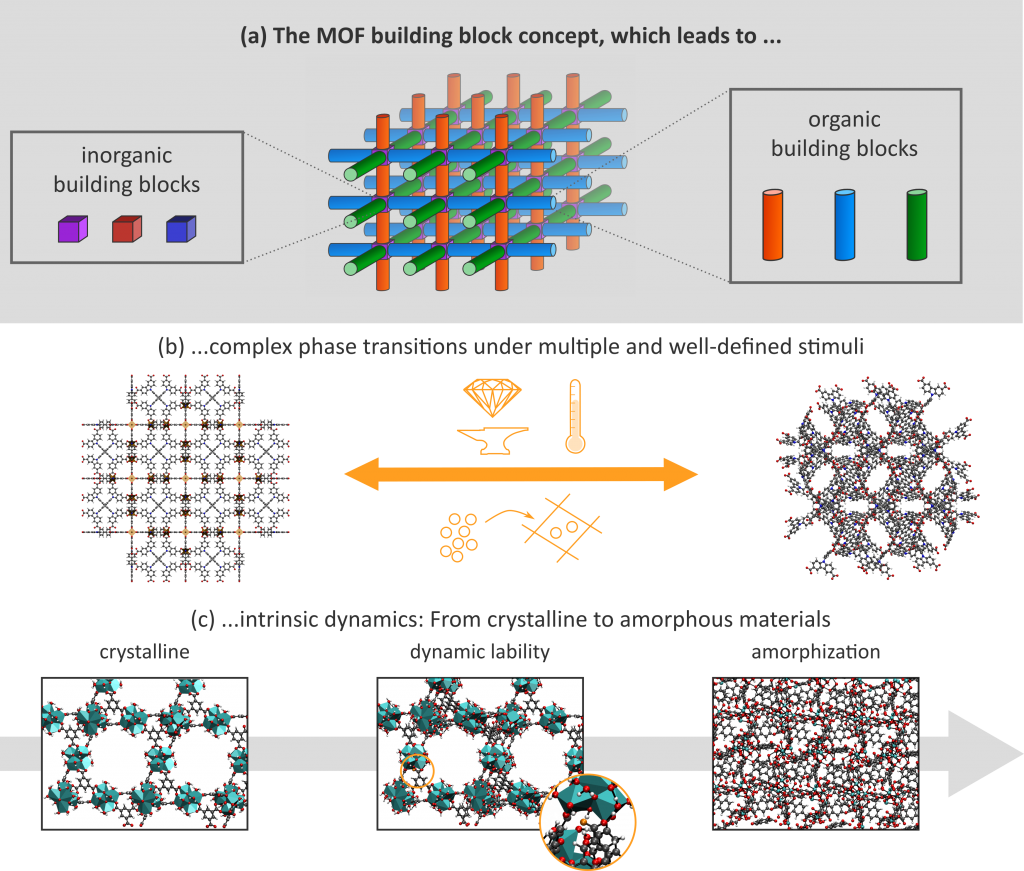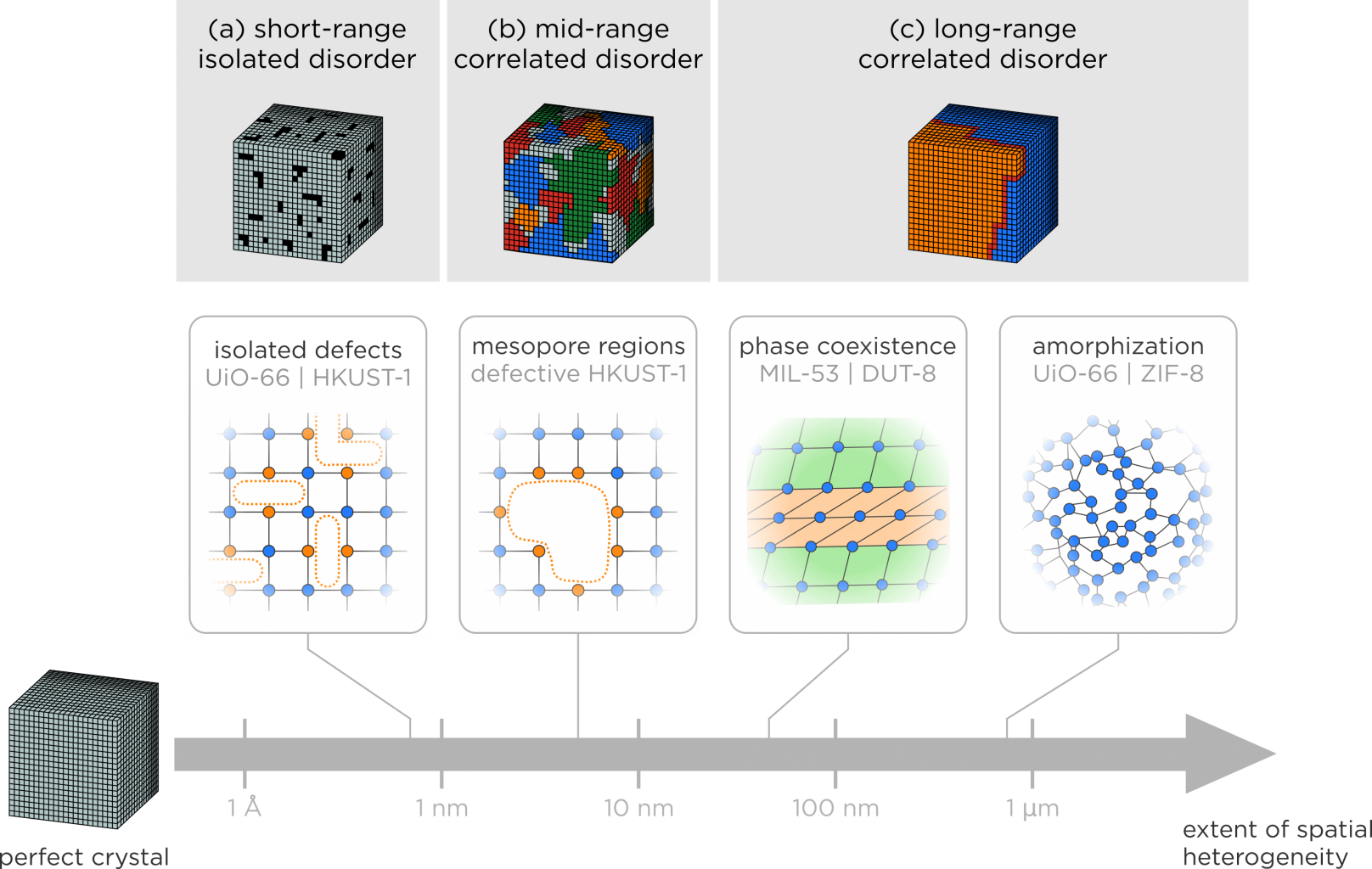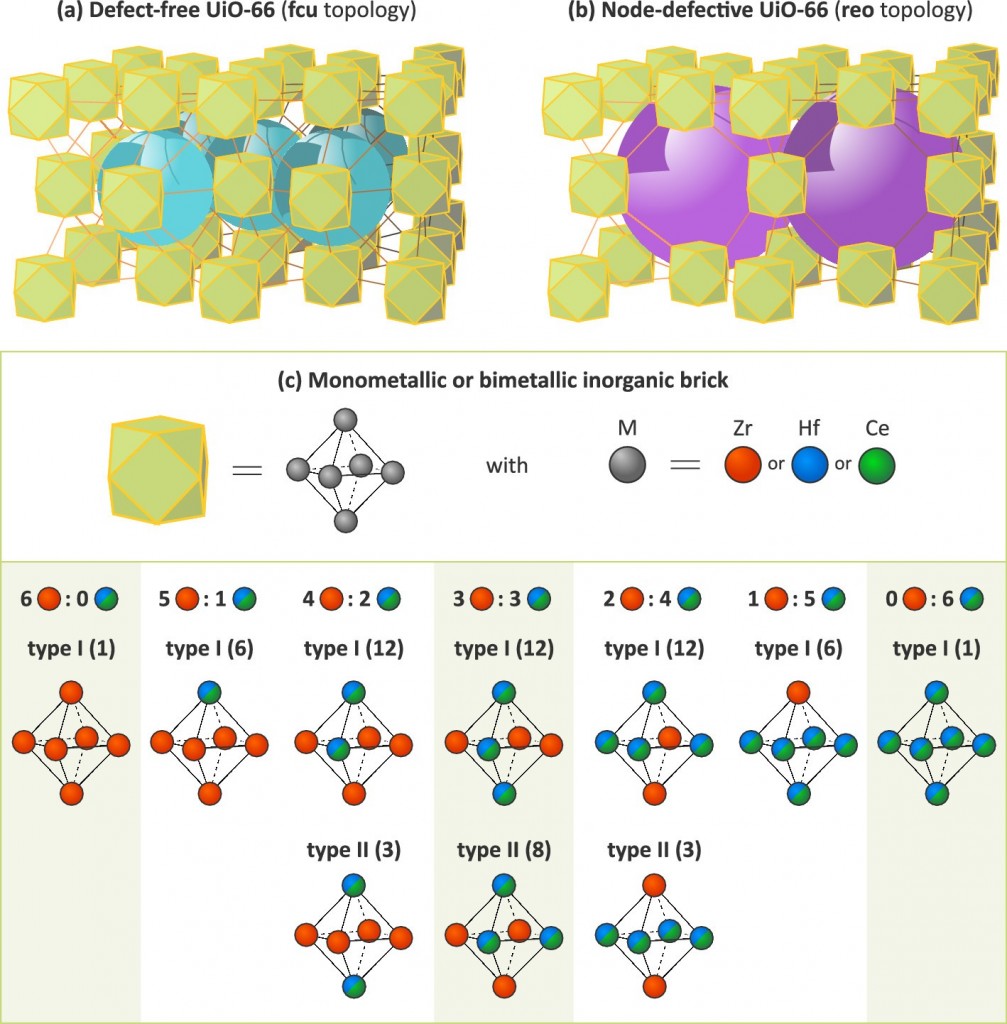Towards realistic models for metal-organic frameworks: How defects impact the spatiotemporal response
Towards realistic models for metal-organic frameworks: How defects impact the spatiotemporal response
Promotor(en): V. Van Speybroeck /25663 / Model and software developmentBackground ad problem
Metal-organic frameworks (MOFs) emerged in the last decades as a very intriguing and versatile class of materials, showing anomalous responses to certain triggers. A few examples of such atypical behavior are negative linear compressibility, where upon exerting pressure, the material expands along one or more directions instead of contracting; negative thermal expansion, where the material contracts upon heating rather than expanding; and negative gas adsorption, where the MOF releases gas from its pores when the gas pressure of the surroundings is increased [1]. These peculiar response properties are inherently linked to the unique building block concept of MOFs (see Figure 1a). Their structure, composed of metal clusters stitched together by organic linkers, yields a broad variety of stronger (covalent, coordinative) and weaker (dispersive, stacking, hydrogen bonds…) interactions. Such bonding pattern combined with the nanoporosity of MOFs gives rise to potential extraordinary flexibility under external stimuli, where the materials can transform between various phases often accompanied by substantial volume changes while maintaining their structural integrity (Figure 1b) [2], but can also impact the material’s resistance towards amorphization [3] (Figure 1c). Enormous efforts have been undertaken to understand and tune these dynamic responses, which poses an enormous challenge as MOFs typically exhibit a broad range of intrinsic time scales varying from molecular vibrations taking place at the picosecond time scale to more collective motions or events associated with activated processes that are much slower and occur on a time scale of seconds or hours. Recently, it became clear that the dynamic response of MOFs is moreover largely impacted by the spatial heterogeneity and crystal size of the material. Downsizing MOF crystals from the micro- to the mesoscale with primary crystallite sizes between 10 nm and 1 μm substantially suppresses their responsive behavior [4]. However, such spatially dependent dynamic behavior is to date a largely unexplored area as current computational and experimental techniques are yet unable to correctly take these effects into account.

Given these consideration the terminology spatiotemporal evolution of the material was coined, referring to the dynamics of the material and its entanglement with the material’s spatial properties. Fundamental insight into the spatiotemporal evolution of MOFs would open up new perspectives to engineer their responses, giving access to new application areas such as the selective recognition of molecules or a tuned history-dependent response upon external stimuli [5]. However, a conditio sine qua non to study spatiotemporal phenomena in MOFs is to first construct realistic models of defective materials on length scales that extend over tens of nanometers and investigate how this spatial disorder affects the dynamic response.
Goal
Within this thesis topic, we intend to construct realistic models for a series of MOFs which are known to demonstrate intrinsic spatial disorder on various length scales (see Figure 2), and systematically investigate, for the first time, how this spatial disorder impacts phenomena such as phase transformations in flexible materials or mechanical stability for rigid materials.

As a first task, realistic structural models will be constructed for the well-known MOFs HKUST-1 and UiO-66 [6, 7]. Various types of spatial disorder intrinsically present in these materials will be considered, including short-range disorder typically associated with isolated defects such as missing linkers, or, for UiO-66, missing nodes and bimetallic building blocks (see Figure 2a and Figure 3) [8]. These models will be built either exhaustively where all possible physical realizations are constructed starting from the symmetry operators of the defect-free material, similar to ref. [3], or via Monte Carlo-based procedures akin to the generalized quasi-chemical approximation [9, 10]. These approaches become increasingly difficult the larger the material under study, and a judicious selection of the most appropriate methods at these various length scales will be necessary. The so constructed models will be verified via quantitative short-range spectroscopic techniques such as infrared, Raman, or nuclear magnetic resonance spectroscopy. A next level of complexity are defects arising when these short-range defects start to conglomerate, forming mid-range spatial disorder such as correlated defect nanoregions or mesopores (see Figure 2b) [11, 12]. Realistic structural models for mesopores will be built by starting from the perfect crystalline material and superimposing the desired mesopore, where atoms falling inside the mesopore are removed. Special care needs to be taken to ensure that the internal surfaces are correctly terminated, which can again be validated with spectroscopic techniques.

Once realistic models for different defective UiO-66 and HKUST-1 MOFs are constructed, a second task within this thesis is to perform large-scale molecular dynamics (MD) simulations to probe their spatiotemporal response under experimental temperatures and pressures. To this end, we will employ our internally developed force fields to perform GPU-based MD simulations via the openMM high-performance toolkit with the aim to construct the pressure-versus-volume and free energy equations of state of these spatially disordered MOFs [13]. This will yield unique insight in how these realistic defects form and how they affect the stability of the material, further paving the way to design defect-engineered MOFs for specific applications.
The student will be actively coached to make him/her acquainted with the advanced simulations techniques early in the thesis year, and to transfer necessary programming skills needed to perform the research.
- Study programmeMaster of Science in Engineering Physics [EMPHYS], Master of Science in Physics and Astronomy [CMFYST]Keywordsspatial disorder, spatiotemporal response, Metal-organic frameworks, correlated defects, mesopore formation, symmetryReferences
[1] F.-X. Coudert, “Responsive Metal–Organic Frameworks and Framework Materials: Under Pressure, Taking the Heat, in the Spotlight, with Friends,” Chem. Mater., vol. 27, no. 6, pp. 1905-1916, 2015.
[2] L. Vanduyfhuys, S. Rogge, J. WIeme, S. Vandenbrande, G. Maurin, M. Waroquier and V. Van Speybroeck, “Thermodynamic insight into stimuli-responsive behaviour of soft porous crystals,” Nat. Commun., vol. 9, p. 204, 2018.
[3] S. Krause, F. S. Reuter, S. Ehrling, V. Bon, I. Senkovska, S. Kaskel and E. Brunner, “Impact of Defects and Crystal Size on Negative Gas Adsorption in DUT-49 Analyzed by In Situ 129Xe NMR Spectroscopy,” Chem. Mater., vol. 32, no. 11, pp. 4641-4650, 2020.
[4] J. D. Evans, V. Bon, I. Senkovska, H.-C. Lee and S. Kaskel, “Four-dimensional metal-organic frameworks,” Nat. Commun., vol. 11, p. 2690, 2020.
[5] S. S.-Y. Chui, S. M.-F. Lo, J. P. H. Charmant, A. G. Orpen and I. D. Williams, “A Chemically Functionalizable Nanoporous Material [Cu3(TMA)2(H2O)3]n,” Science, vol. 283, no. 5405, pp. 1148-1150, 1999.
[6] J. H. Cavka, S. Jakobsen, U. Olsbye, N. Guillou, C. Lamberti, S. Bordiga and K. P. Lillerud, "A new zirconium inorganic building brick forming metal organic frameworks with exceptional stability," J. Am. Chem. Soc., vol. 130, no. 42, pp. 13850-13851, 2008.
[7] S. M. J. Rogge, P. G. Yot, J. Jacobsen, F. Muniz-Miranda, S. Vandenbrande, J. Gosch, V. Ortiz, I. E. Collings, S. Devautour-Vinot, G. Maurin, N. Stock and V. Van Speybroeck, “Charting the metal-dependent high-pressure stability of bimetallic UiO-66 materials,” ACS Materials Lett., vol. 2, no. 4, pp. 438-445, 2020.
[8] S. M. J. Rogge, J. Wieme, L. Vanduyfhuys, S. Vandenbrande, G. Maurin, T. Verstraelen, M. Waroquier and V. Van Speybroeck, “Thermodynamic Insight in the High-Pressure Behavior of UiO-66: Effect of Linker Defects and Linker Expansion,” Chem. Mater., vol. 28, no. 16, pp. 5721-5732, 2016.
[9] A. Sher, M. van Schilfgaarde, A.-B. Chen and W. Chen, "Quasichemical approximation in binary alloys," Phys. Rev. B, vol. 36, no. 8, pp. 4279-4295, 1987.
[10] A. Schleife, M. Eisenacher, C. Rödl, J. Furthmüller and F. Bechstedt, "Ab initio description of heterostructural alloys: Thermodynamic and structural properties of MgxZn1−xO and CdxZn1−xO," Phys. Rev. B, vol. 81, no. 24, p. 245210, 2010.
[11] M. J. Cliffe, W. Wan, X. Zou, P. A. Chater, A. K. Kleppe, M. G. Tucker, H. Wilhelm, N. P. Funnell, F.-X. Coudert and A. L. Goodwin, “Correlated defect nanoregions in a metal–organic framework,” Nat. Commun., vol. 5, p. 4176, 2014.
[12] Z. Fang, J. P. Dürholt, M. Kauer, W. Zhang, C. Lochenie, B. Jee, B. Albada, N. Metzler-Nolte, A. Pöppl, B. Weber, M. Muhler, Y. Wang, R. Schmid and R. A. Fischer, “Structural Complexity in Metal–Organic Frameworks: Simultaneous Modification of Open Metal Sites and Hierarchical Porosity by Systematic Doping with Defective Linkers,” J. Am. Chem. Soc., vol. 136, no. 27, pp. 9627-9636, 2014.
[13] S. M. J. Rogge, M. Waroquier and V. Van Speybroeck, “Reliably Modeling the Mechanical Stability of Rigid and Flexible Metal–Organic Frameworks,” Acc. Chem. Res., vol. 51, no. 1, pp. 138-148, 2018.
